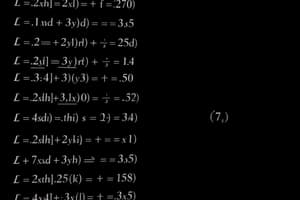Podcast
Questions and Answers
Which of the following statements is not true about the real number system?
Which of the following statements is not true about the real number system?
- The real number system is finite. (correct)
- The real number system has the Archimedean property.
- The real number system is complete.
- The real number system is an ordered field.
What does the Cauchy criterion for convergence of a sequence of real numbers state?
What does the Cauchy criterion for convergence of a sequence of real numbers state?
- A sequence converges if and only if its terms eventually become arbitrarily close to each other. (correct)
- A sequence converges if and only if its terms are eventually monotone.
- A sequence converges if and only if its terms eventually become arbitrarily close to a fixed value.
- A sequence converges if and only if its terms are eventually bounded.
Which of the following tests can be used to determine the convergence of an alternating series?
Which of the following tests can be used to determine the convergence of an alternating series?
- Integral test
- Ratio test
- Leibniz test (correct)
- Comparison test
What is the radius of convergence of the power series $ \sum_{n=0}^{\infty} \frac{x^n}{n!} $ ?
What is the radius of convergence of the power series $ \sum_{n=0}^{\infty} \frac{x^n}{n!} $ ?
What is the derivative of a function at a point called?
What is the derivative of a function at a point called?
What does the mean value theorem state?
What does the mean value theorem state?
Which of the following is a property of the Riemann integral?
Which of the following is a property of the Riemann integral?
What is the difference between a double integral and a triple integral?
What is the difference between a double integral and a triple integral?
What is the property of a sufficient statistic that guarantees its completeness?
What is the property of a sufficient statistic that guarantees its completeness?
Which of the following is NOT a property of the Brownian motion process?
Which of the following is NOT a property of the Brownian motion process?
What is the relationship between the Cramer-Rao inequality and the efficiency of an estimator?
What is the relationship between the Cramer-Rao inequality and the efficiency of an estimator?
In the context of hypothesis testing, what does the Neyman-Pearson lemma guarantee about the most powerful test?
In the context of hypothesis testing, what does the Neyman-Pearson lemma guarantee about the most powerful test?
Which of the following is a non-parametric test used to compare two independent samples?
Which of the following is a non-parametric test used to compare two independent samples?
In a Markov chain, what does a state being recurrent mean?
In a Markov chain, what does a state being recurrent mean?
What is the relationship between the central limit theorem and the delta method?
What is the relationship between the central limit theorem and the delta method?
Which of the following statements about the method of moments estimators is true?
Which of the following statements about the method of moments estimators is true?
Flashcards
Convergence of Sequences
Convergence of Sequences
A sequence of numbers approaches a specific value as terms increase.
Cauchy Criterion
Cauchy Criterion
A sequence converges if, after a certain point, all terms are close to each other.
Taylor's Theorem
Taylor's Theorem
A function can be approximated by polynomials using its derivatives at a point.
Rank of a Matrix
Rank of a Matrix
Signup and view all the flashcards
Eigenvalues
Eigenvalues
Signup and view all the flashcards
Bayes’ Theorem
Bayes’ Theorem
Signup and view all the flashcards
Poisson Distribution
Poisson Distribution
Signup and view all the flashcards
Random Variables
Random Variables
Signup and view all the flashcards
Jointly Distributed Random Variables
Jointly Distributed Random Variables
Signup and view all the flashcards
Marginal Distribution
Marginal Distribution
Signup and view all the flashcards
Conditional Expectation
Conditional Expectation
Signup and view all the flashcards
Central Limit Theorem
Central Limit Theorem
Signup and view all the flashcards
Neyman-Pearson Lemma
Neyman-Pearson Lemma
Signup and view all the flashcards
Likelihood Ratio Test
Likelihood Ratio Test
Signup and view all the flashcards
Rao-Blackwell Theorem
Rao-Blackwell Theorem
Signup and view all the flashcards
Empirical Distribution Function
Empirical Distribution Function
Signup and view all the flashcards
Study Notes
Calculus
- Real number system: complete ordered field, Archimedean property
- Sequences: convergence, bounded, monotonic, Cauchy criterion
- Series: convergence, absolute/conditional, power series, radius of convergence
- Functions of a real variable: limits, continuity, monotone functions, uniform continuity, differentiability, Rolle's theorem, mean value theorems, Taylor's theorem, L'Hôpital's rule, maxima/minima
- Riemann integration, improper integrals
- Functions of several variables: limits, continuity, partial derivatives, directional derivatives, gradient, Taylor's theorem, total derivative, maxima/minima, saddle point, Lagrange multipliers, double/triple integrals
Matrix Theory
- Subspaces: span, linear independence, basis, dimension, row space, column space, rank, nullity, row reduced echelon form, trace, determinant, inverse of a matrix
- Systems of linear equations
- Inner products in Rⁿ and Cᵐ, Gram-Schmidt orthonormalization
- Eigenvalues, eigenvectors, characteristic polynomial, Cayley-Hamilton theorem
- Symmetric, skew-symmetric, Hermitian, skew-Hermitian, orthogonal, unitary matrices
- Equivalence/similarity, diagonalizability, positive definite/positive semi-definite matrices, quadratic forms, singular value decomposition
Probability
- Axiomatic definition of probability: properties, conditional probability, Bayes' theorem, independence of events
- Random variables: distributions, probability mass function, probability density function, properties, expectation, moments, moment generating function, quantiles
- Distributions of functions of a random variable
- Chebyshev's, Markov's, and Jensen's inequalities
- Standard discrete/continuous univariate distributions (Bernoulli, binomial, geometric, negative binomial, hypergeometric, discrete uniform, Poisson, continuous uniform, exponential, gamma, beta, Weibull, normal)
Standard Discrete and Continuous Univariate Distributions
- Include specific distributions from the probability section (Bernoulli, Binomial, etc.)
Jointly Distributed Random Variables
- Distribution functions, probability mass/density functions, marginal and conditional distributions, conditional expectation, moments, product moments, simple correlation coefficient, joint moment generating function, independence of random variables, functions of random vector, distributions of order statistics
Convergence
- Convergence (in distribution, probability, almost surely, r-th mean) and relationships. Slutsky's lemma, Borel-Cantelli lemma, weak and strong laws of large numbers, central limit theorem (for i.i.d. random variables), delta method
Stochastic Processes
- Markov chains with finite/countable state space, classification of states, limiting behavior of n-step transition probabilities, stationary distribution, Poisson process, birth-and-death process, pure-birth/pure-death, Brownian motion
Estimation
- Sufficiency, minimal sufficiency, factorization theorem, completeness, completeness of exponential families, ancillary statistic, Basu's theorem, unbiased estimation, uniformly minimum variance unbiased estimation, Rao-Blackwell theorem, Lehmann-Scheffe theorem, Cramer-Rao inequality, Method of Moments, maximum likelihood estimators, interval estimation, pivotal quantities, confidence intervals, coverage probability
Hypothesis Testing
- Neyman-Pearson lemma, most powerful tests, monotone likelihood ratio (MLR) property, uniformly most powerful tests, uniformly most powerful unbiased tests, uniformly most powerful unbiased tests (for exponential families), likelihood ratio tests, large sample tests
Non-parametric Statistics
- Empirical distribution function, goodness of fit tests, chi-square test, Kolmogorov-Smirnov test, sign test, Wilcoxon signed rank test, Mann-Whitney U-test, rank correlation coefficients (Spearman, Kendall)
Multivariate Analysis
- Multivariate normal distribution, properties, conditional/marginal distributions, maximum likelihood estimation of mean vector and dispersion matrix, Hotelling's T² test, Wishart distribution, multiple/partial correlation coefficients
Regression Analysis
- Simple/multiple linear regression, R², adjusted R², distributions of quadratic forms of random vectors, Fisher-Cochran theorem, Gauss-Markov theorem, tests for regression coefficients, confidence intervals
Studying That Suits You
Use AI to generate personalized quizzes and flashcards to suit your learning preferences.




